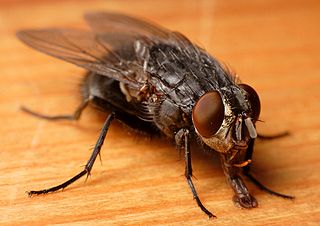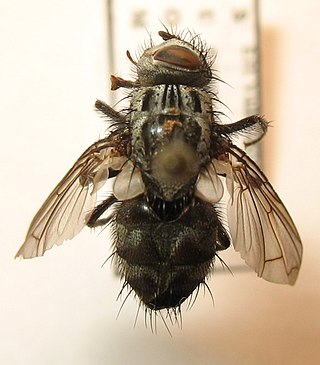
Cluster flies are flies of the genus Pollenia in the family Polleniidae. Unlike the more familiar blow flies, such as the bluebottle genus Phormia they do not lay eggs in human food. They parasitise earthworms; the females lay their eggs near earthworm burrows, and the larvae then feed on the worms. But the biology of this group is relatively poorly known and a few have been recorded from other hosts including caterpillars and bees.

Calliphora is a genus of blow flies, also known as bottle flies, found in most parts of the world, with the highest diversity in Australia. The most widespread species in North America area Calliphora livida, C. vicina, and C. vomitoria.

Bengalia is a genus of blow flies in the family Calliphoridae with one authority considering the genus to belong to a separate family Bengaliidae. These bristly and, unlike the greens and blues of most calliphorids, dull coloured flies, are especially noted for their relationship to ants. Little is known of their biology and life-cycle, although adults of many species are kleptoparasitic on ants and will snatch food and pupae being carried by ants or feed on winged termites. The apt name “Highwayman Fly” was given by an early observer of their way of robbing ants. Very little is known about their breeding habits. The genus is found in the Afrotropical and oriental region with one species from Australia possibly a recent introduction.

Billaea is a genus of flies in the family Tachinidae. Most larvae, where known are parasitoids of Coleoptera or Lepidoptera (Pyralidae)

Carcelia is a genus of flies in the family Tachinidae.

Cylindromyia is a genus of flies in the family Tachinidae.

Nemorilla is a genus of flies in the family Tachinidae.

Phasia is a genus of flies in the family Tachinidae.

Pseudogonia is a genus of flies in the family Tachinidae.

Siphona is a genus of flies in the family Tachinidae.
Vibrissina is a genus of flies in the family Tachinidae.

Winthemia is a genus of flies in the family Tachinidae.

Leskia is a genus of flies in the family Tachinidae.

Loewia is a genus of flies in the family Tachinidae.

Condylostylus is a genus of flies in the family Dolichopodidae. It is the second largest genus in the subfamily Sciapodinae, with more 250 species included. It has a high diversity in the Neotropical realm, where 70% of the species occur.

Phasiinae is a subfamily of flies in the family Tachinidae. Except for the small tribe Strongygastrini members of this subfamily attack only Heteroptera.
Cosmina is a genus of flies in the family Rhiniidae.

Polleniidae is a family of flies in the order Diptera. There are at least 6 genera and more than 190 described species placed definitively in Polleniidae, and other genera whose placement here is considered uncertain. The largest genus is Pollenia, with close to 190 species of flies commonly called "cluster flies".

Rhiniidae is a family of flies in the order Diptera, and formerly included in the Calliphoridae. There are around 30 genera and 370 described species in Rhiniidae.
Dexopollenia is a genus of flies in the family Polleniidae.
















